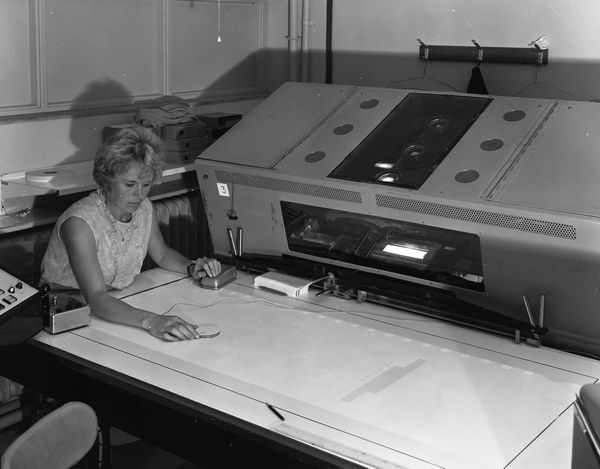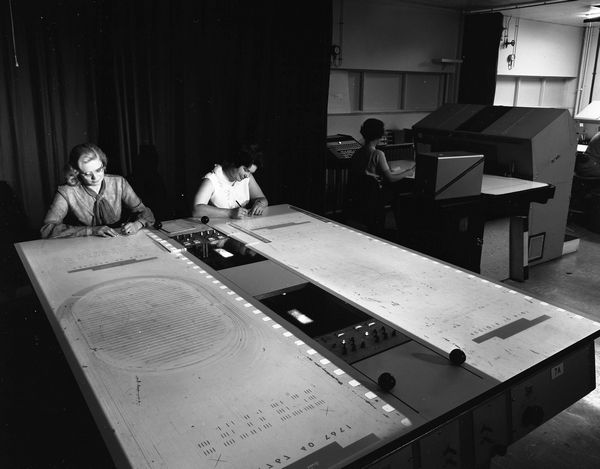

During the year 1968-69 the computers (the IBM System 360/75 and the Honeywell DDP-224) have operated for three shifts on weekdays, plus occasional, but increasingly frequent, single shifts at weekends. The number of jobs passing through the 360 per week has increased from 1800 to 2500, and the number of magnetic tapes held now exceeds 1000. Computer operators regularly run the HPD and CYCLOPS film-measuring machines, which are attached to the 360 via the DDP. The year has seen many changes and additions to the hardware of both machines, and to the system software. Figure 56 shows the system in block diagram form.
The 360 now has a second card-reader, to act as a spare for the main one and to allow the input of special jobs at any time without interfering with the main input stream. A fourth 9-track magnetic tape drive has arrived, which should ease congestion among 2-tape jobs. A magnetic drum has been ordered, and will be installed early next year. This is to reduce system overheads during transitions from one job-step to another, but will payoff only when a selector sub-channel for the magnetic tapes is also fitted, permitting the tapes to be taken off the channel which is due to be shared by the drum and the IBM-2311 magnetic disc. Telecommunications hardware has also been installed to serve the link between the 360 and the INDRA project at London Institute of Computer Science. A terminal adaptor now connects the 360 with the IBM 1130 computer which will control the activities of several rough-digitising machines.
On the DDP-224, the magnetic tape equipment has been removed and replaced by a third Direct Memory Access channel to give more efficient service to on-line experiments. A Fully Buffered Channel facilitates output to the Visual Display equipment which is now beginning to be used for the inspection of photographs which have already been scanned and stored. The facilities for associated light-pen have also been improved. Changes to the several on-line typewriters will greatly increased the convenience of these both as input and output devices. The high-address 4096 words of core store are now of the same type as the remainder.
In the field of system software, the first half of the year was a period of consolidation during which users were disturbed as little as possible by reforms. User-routines continued to be developed for the DDP side of the on-line data-collection system DAEDALUS, and Fortran usable routines were written to enable Rutherford programmers to use the Stromberg-Carlson graphic output equipment at the Atlas Laboratory.
During the second half of the year plans were made for exploiting the new IBM operating system, MFT2. This was designed to give the possibility of running more than one stream of off-line jobs as well as the long-lasting on-line jobs which MFT1 allowed, although these too would benefit by improved scheduling methods. The DAEDALUS sub-system was reformed so as to be as nearly independent as possible of later changes to the operating system, and the overhaul has proved beneficial to all on-line applications. After testing, the MFT2 system was brought in to use in October. Intensive use revealed many software faults, the diagnosis of which was made difficult by the fact that some of the new software employed hardware features not previously used. Much effort was devoted to overcoming problems, but at the same time thought was given to the best usage of the improved job-accounting information which was now available.
A software package which will give fast displays on the cathode-ray tube output device, and accept light pen input there from, is currently being checked out.
Planning is in progress to ensure the optimum use of the space that will become available when the 4-bay extension to Building R1 is completed.
A fully operational routine system is now working with CYCLOPS (a device where the film raster scanned by a flying spot from a CRT); The machine is currently measuring 35 mm film from a Nimrod experiment on the leptonic decay of neutral kaons and a Daresbury experiment (e-p scattering). So far some 150,000 events have been measured on the Nimrod experiment and 5,000 on the Daresbury one. The machine is on-line to the IBM 360/75 for upwards of 12 hours per day and measures at the rate of 400-600 events per hour.
A general program has been developed for finding tracks directly from CYCLOPS digitising. This program is now in a production state for the K13 experiment and is in the process of analysing the 150,000 measured events.
No prescanning information is required for this program but development is underway on a patch up system to rescue good events which have failed in the analysis program. Using an interactive visual display an operator can give the program some help in identifying all associating tracks.
The rebuilt HPD1 machine is now fully operational and has been in production for much of the year. Measurements for the first experiment (K-p interactions in the 80 cm Saclay chamber) have been completed. This involved over 30,000 two-prong events, and the results had the high accuracy expected of an HPD (2-4 microns on film). Measurements for the next experiment have started.
The HPD machine is also capable of measuring the bubble density of tracks. This measurement is, however, dependent on the quality of the film and the consistency of the operating condition of the bubble chamber. Bubble density measurements were used in the first experiment but with only limited success, and work is in progress to produce more reliable results. A display under computer control is being developed, so that some failed tracks can be corrected with a light pen. Modifications to the filtering program, and tests of the minimum guidance system and for track matching which correlates stereoscopic views, are in progress.
The rough digitiser system is used to provide guidance measurements for the HPD film scanner. The measurements (accurate to 0.001 inch) which are obtained by scanners using co-ordinate measuring tables need to be checked for consistency before being stored on the disc store of the IBM 360/75, and this is most conveniently done by working directly on-line with the computer.
An IBM 1130 computer with a 16K core store and disc storage was delivered to the Laboratory in April 1968. It is now connected to the IBM 360/75 via the 2701 data adaptor and a hardware interface built at the Rutherford Laboratory. A fifteen way input/output multiplexor has also been designed and commissioned in the Laboratory; six rough digitisers with their typewriters will be connected initially to this interface.
Programs for the system are in an advanced state and a preliminary evaluation of the system will be made using one of the rough digitisers.

